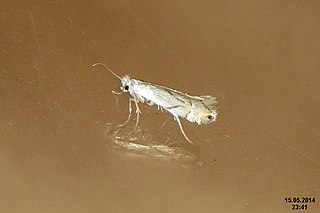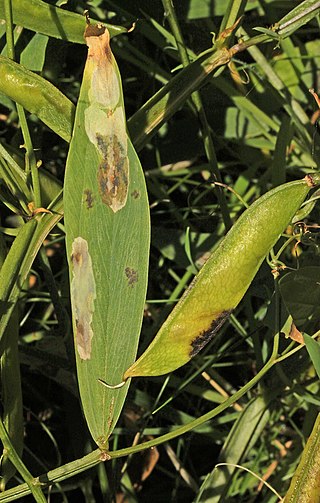
Eudonia delunella is a species of moth of the family Crambidae. It was described by Henry Tibbats Stainton in 1849 and is found in Europe.

Cosmopterix is a large genus of moth in the family Cosmopterigidae.

Eriocrania sangii, the large birch purple, is a moth of the family Eriocraniidae found in Europe and described by John Henry Wood in 1891. The moth can be found flying in sunshine around birch trees and the larvae feed on birch leaves.

Grammodes stolida, the geometrician, is a moth of the family Erebidae. The species was first described by Johan Christian Fabricius in 1775. It is found in Africa, southern Europe, most of Asia and Australia. It migrates to central and northern Europe as far north as England, Denmark and Finland.

Parornix anglicella is a moth of the family Gracillariidae found in Asia and Europe. It was described in 1850, by the English entomologist Henry Tibbats Stainton, from a specimen from Lewisham, Kent.

Stigmella plagicolella is a moth of the family Nepticulidae described by Henry Tibbats Stainton in 1854. It is found in all of Europe and the Near East.

Stigmella salicis is a moth of the family Nepticulidae which is found in Europe. It was first described by the English entomologist, Henry Stainton in 1854. The type locality is from England.

Leucoptera malifoliella, the pear leaf blister moth, ribbed apple leaf miner or apple leaf miner, is a moth of the Lyonetiidae family that can be found in all of Europe.

Stigmella cypracma is a species of moth of the family Nepticulidae. It is endemic to New Zealand and has been observed in the North and South Islands. The larvae of this species are leaf miners and pupate within their mines. The larval host species is Brachyglottis repanda. Adult moths are on the wing in February and September to November. This species has two generations per year.

Enteucha acetosae, the pygmy sorrel moth, is a moth of the family Nepticulidae found in Europe. It is one of the smallest moths in the world with some having a wingspan of only 3mm. The larvae mine the leaves of docks, leaving bright red tissue around the mines.

Leucoptera laburnella is a moth in the family Lyonetiidae. It is found in most of Europe, except the European part of Russia and the southern part of the Balkan Peninsula. It is also found in North America.

Leucoptera lathyrifoliella is a moth in the Lyonetiidae family. It is found in Finland, Germany and England.

Leucoptera orobi is a moth in the family Lyonetiidae. It is found in Finland, Estonia, Ireland, Latvia and Scotland.

Parornix devoniella is a moth of the family Gracillariidae found in Europe. The larvae are leaf miners, feeding on the tissue inside the leaves of hazels Corylus species.

Cosmopterix nishidai is a moth of the family Cosmopterigidae. It is known from Costa Rica.

Cosmopterix pulchrimella, the beautiful cosmopterix moth, is a moth of the family Cosmopterigidae. It is known from the United States and Canada. It is also present in the Palearctic realm, where it is known from the Mediterranean Basin, from Portugal to the western Transcaucasus, north to Switzerland and Hungary. It has also been recorded from the Azores, the Canary Islands and Madeira. It has recently been found in southern England.

Pebobs ipomoeae is a moth of the family Cosmopterigidae. It is known from Florida.

Aproaerema anthyllidella is a moth of the family Gelechiidae. It is found in most of Europe, Kyrgyzstan, Iran and North America.

Ichneutica pelanodes is a moth of the family Noctuidae. It is endemic to New Zealand and has been found in scattered locations in the North, South and Stewart Islands. I. pelanodes is easily confused with I. skelloni as the two species are visually extremely similar. In the North Island though the range of the two species appears not to overlap. Generally of the two species I. pelanodes tends to be darker in appearance. I. pelanodes inhabits wetlands but the life history of this species is unknown as are the host species of its larvae. Adults are on the wing from October to February and are attracted both to sugar and light traps.
Scrobipalpa hyoscyamella is a moth in the family Gelechiidae. It was described by Henry Tibbats Stainton in 1869. It is found in Portugal, Spain, southern France, Austria and Romania.















